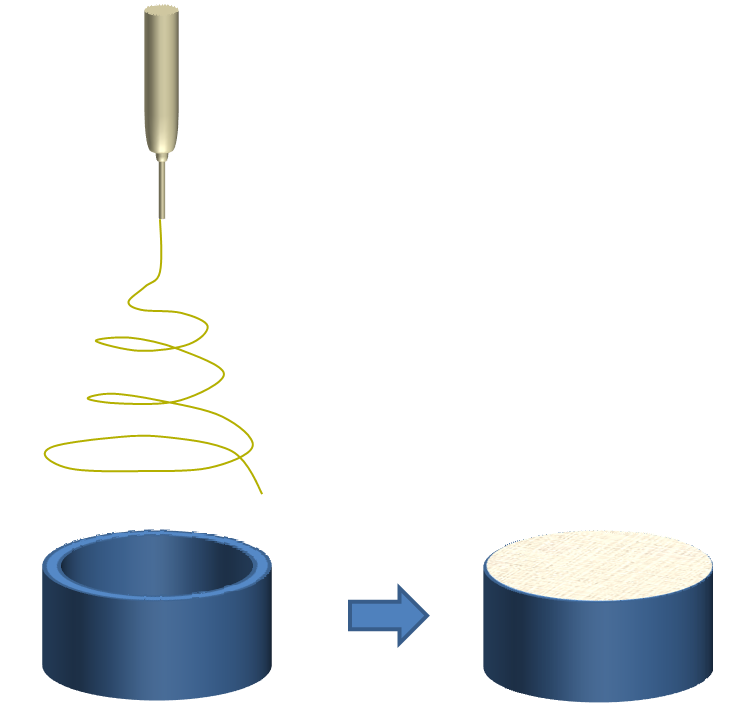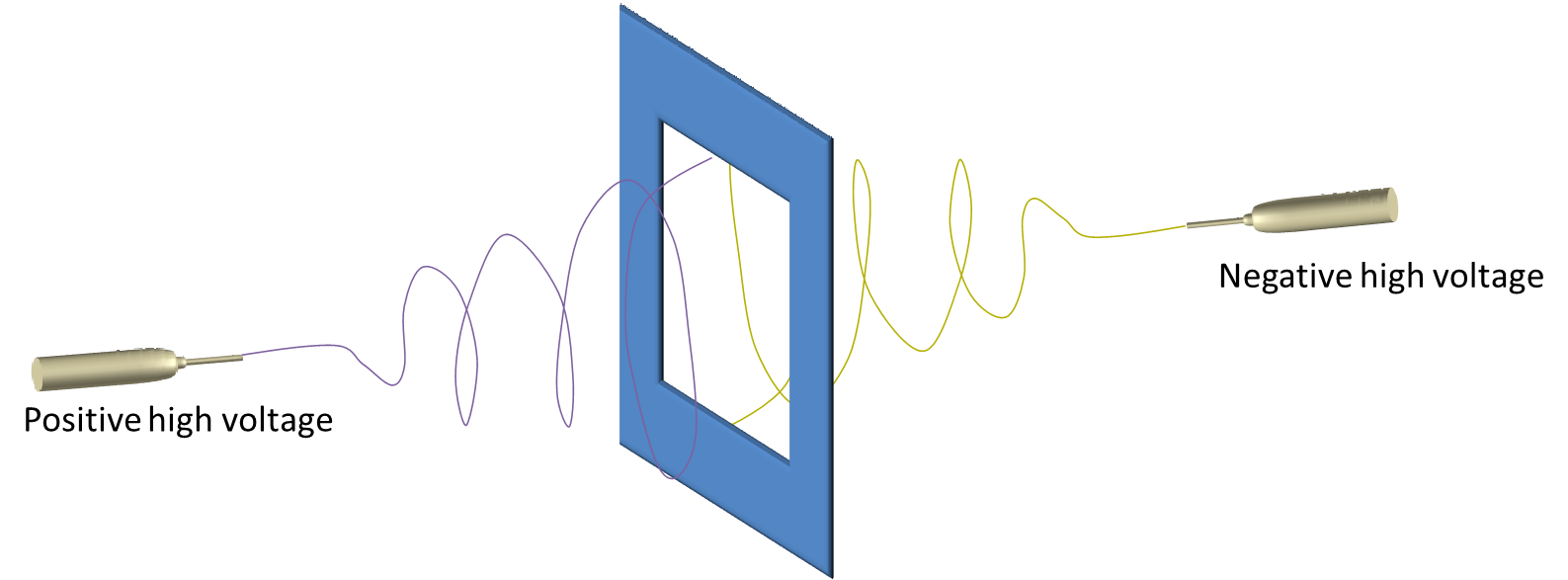There are some cases where the electrospun membrane needs to be removed from the collector for use a standalone membrane. In tissue repair graft, a membrane made out of only nanofibers may be required to ensure minimal inflammatory reaction. Unfortunately for conventional electrospinning onto a metal plate collector, the electrospun membranes tend to stick onto the collector and it may not be possible to remove the membrane without damaging the surface in contact with the collector. To be able to remove the electrospun membrane from the collector, it is good to understand the factors influencing fiber adhesion to the substrate. Three possible factors that affect fiber to substrate adhesion are surface contact area, substrate surface asperities and electrostatic residual charges [Zhang et al 2020]. With greater surface contact area between the fibers and substrate, there is a greater amount of van der Waal attraction between them. Thinner electrospun fibers generally give greater density of fibers per unit area. Therefore, factors that give rise to thinner fibers will yield stronger adhesion of the electrospun layer to the substrate. Substrate surface asperities work as a mechanical lock onto the electrospun fiber layer. Zhang et al (2020) showed that electrospun polyvinylpyrrolidone (PVP) layer adhered more strongly to rough wood pulp paper to smooth silicon paper. In electrospinning, there will be charges in the electrospun fiber. Depending on the substrate material, the speed of electrostatic decay may differ. When the speed of decay is slow as electrospinning to a non-conducting substrate, the residual charges on the fibers will repel incoming fibers. Therefore, the deposited fiber layer will be loose on the substrate and there is less contact between the fibers and the substrate surface. This will result in less adhesion to the substrate surface. In many instances, it may not be feasible to change the electrospinning material and conditions for easier removal of the electrospun membrane layer. Nevertheless, there are a few possible ways to achieve this.
Immediate peeling of membrane after collection
In some cases, the membrane may be peeled off with limited damage when this is carried out immediately after electrospinning. Left overnight, the membrane tends to stick tighter to the membrane surface. This may be due to residual solvents on the fibers that bond the fiber to the collector surface during overnight drying.
Glass collector
A glass collector is rigid with a smooth surface. This will facilitate the removal of the coated fibrous membrane.
Teflon coated surface
If there is adhesion between the membrane and the normal collector substrate, a non-stick coating may be applied to the collector surface especially when most plastic makes poor collector. A thin non-stick coating may still allow the earthed collector to encourage fiber deposition on its surface.
Heat-treatment
Technically, heat treatment gives the resultant membrane greater resistance to tearing and this allows it to be peeled off the collector surface with minimal damage.
Separating medium
A water-soluble separating medium may be applied on the collector surface and allowed to dry prior to deposition of nanofibers. A possible separating medium is alginate solution which is commonly used in dentistry. The resultant membrane may be removed from the collector by dipping the collector with the membrane on it in water to dissolve the alginate.
Water collector
A water collector is the most direct method of collecting membrane without any contaminants. Fiber collected on a shallow pool of water will float on the surface and has been used in the preparation of stacked nanofibrous membranes [Tzezana et al 2008]. The resultant membrane can be simply removed off the surface of the water using a mesh plate or a slotted kitchen turner to prevent tearing the wet membrane. However, it is advisable to use a focusing electrode to constrain the deposition area of the fibers so that the deposition area will not cover the whole collector.
Membrane without substrate
If the electrospun membrane can be collected without any underlying substrate, the difficulty associated with peeling membrane off the substrate will not even be present. It has already been demonstrated using parallel electrodes system that fibers can be deposited across an air gap to get aligned fibers. Using the same concept, fibers may be deposited on a ring of sufficient height (about 5 mm) for a small membrane area of diameter around 15 mm to 50 mm. Given sufficient height and provided that the ring inner diameter is sufficiently small, the fibers will be able to support themselves across the cavity. Another similar setup is to use a ring or cavity made from a rigid film and held in an upright position and electrospin from a horizontal position. The resultant membrane may be removed using a punch from the other side of the cavity.
Setup using a parallel electrode concept suffers from relatively poor product rate as the fibers tend to preferentially deposit on the substrate (given its greater potential difference from the source) than across the cavity. To improve production rate, electrospinning can be carried out using opposing polarity voltage supply one from each side of the cavity or window. The incoming electrospinning jet of opposing polarity will cause the fibers to attract to one another at the cavity [Morozov et al 2007]. However, to avoid the fibers clumping together in the cavity and falling off without any support from the surrounding wall, it may be better to initiate electrospinning on one side to allow some fiber deposition on the wall prior to switching on the other electrospinning setup.
Wetting medium
Adhesion between two surfaces may be due to microscopic bonding between the surfaces. The adhesion layer may be very thin and could be easily dissolved using a suitable wetting medium. Such wetting medium typically has low surface tension such that it can easily penetrate into the interface between the two surfaces.
Similarly, adhesion of electrospun membrane to a surface may easily be broken using a wetting medium. To separate melt electrospun polycaprolactone scaffolds from the deposition substrate, Fuchs et al (2019) used ethanol. Ethanol has a low surface tension and can easily penetrate into the interface of the electrospun fiber and stainless steel collector. Other fluid such as propanol and butane may also be considered depending on material and application.
Published date: 12 November 2013
Last updated: 15 September 2020
▼ Reference
-
Fuchs A, Youssef A, Seher A, Hochleitner G, Dalton P D, Hartmann S, Brands R C, Muller-Richter U D A, Linz C. Medical-grade polycaprolactone scaffolds made by melt electrospinning writing for oral bone regeneration - a pilot study in vitro. BMC Oral Health 2019; 19: 28.
Open Access
-
Morozov V N, Vsevolodov N N. Electrospray-Neutralization Method for Manufacturing Free and Supported Nanomats. Adv. Mater. 2007; 19: 4381.
-
Tzezana R, Zussman E and Levenberg S (2008) A Layered Ultra-Porous Scaffold for Tissue Engineering, Created via a Hydrospinning Method. Tissue Engin. 14 281-288.
-
Zhang B, Yan X, Xu Y, Zhao H S, Yu M, Long Y Z. Measurement of Adhesion of In Situ Electrospun Nanofibers on Different Substrates by a Direct Pulling Method. Advances in Materials Science and Engineering 2020; 7517109: 8 pages.
Open Access
▲ Close list
 ElectrospinTech
ElectrospinTech


